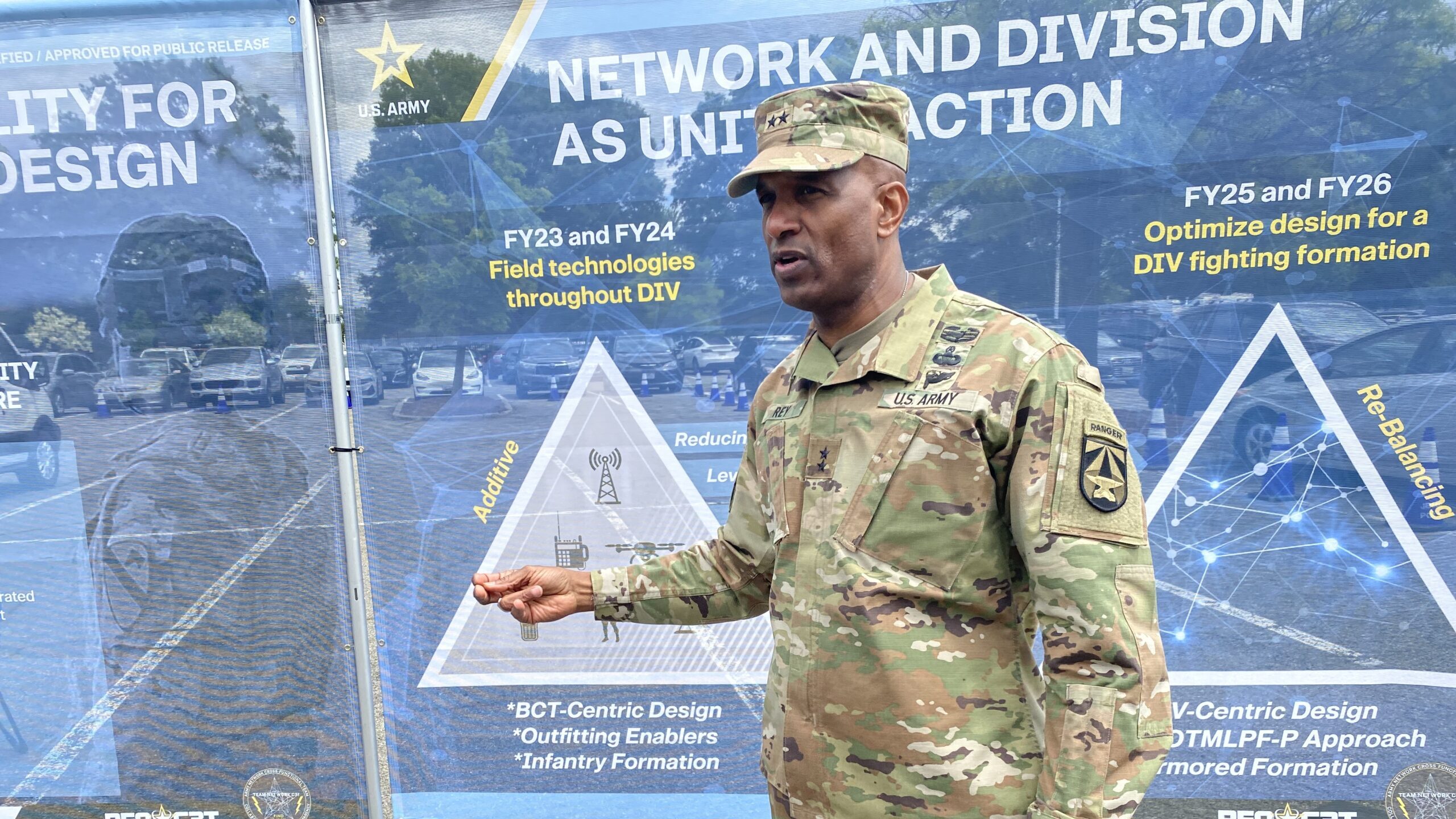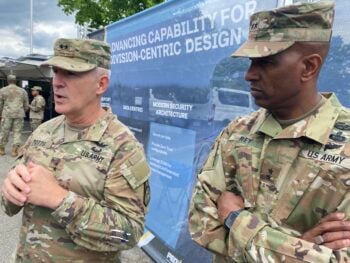SYDNEY J. FREEDBERG JR.

Maj. Gen. Jeth Rey briefs reporters at Fort Myer in May 2023. (Sydney J. Freedberg Jr. photo for Breaking Defense)
FORT MYER, Va. — As ceremonial cannons boomed intermittently in the distance, the two two-star generals tasked with modernizing the Army’s combat networks laid out how the lessons of Ukraine are forcing the service to speed up — both in acquisitions and on the battlefield.
“We need to be on the move,” said Maj. Gen. Jeth Rey, head of the Network Cross Functional Team at Army Futures Command. If US Army units, as currently equipped and organized, had to fight a high-intensity conventional conflict like the one ongoing in Iraq, their large and slow-moving headquarters units would be located by enemy drones or electronic sensors and struck by long-range missiles, rockets, or cannon fire in “minutes” of stopping to set up their communications gear.
“We don’t believe that their command posts are going to survive,” Rey said. “We can’t halt” to set up radio antennas and get connected to the network. Instead, the service needs command posts that can stay connected and communicate continuously while on the move.
That kind of mobility may require slimming down the complexity and capability of network equipment in smaller, front-line units like battalions and even brigades, said Rey and Maj. Gen. Tony Potts, the Army’s acquisition Program Executive Officer for tactical communications (PEO-C3T). The generals spoke at a briefing for reporters during a demonstration of Army communications tech.
One big example: classified networks. Today, Potts explained, units as small as front-line battalions — as few as 400 soldiers — are equipped with the Command Post Computing Environment, which requires bulky “tactical servers.” But if you want more mobile battalions, and you’re willing to let them rely on higher headquarters for some functions, “do you really need that level of command post computing inside a battalion formation?” he asked. What if you gave battalions smaller, cheaper systems available on the civilian market, networks not certified to handle classified data but still using robust “commercial standard encryption” — a standard known as “Secure But Unclassified – Encrypted” (SBUE).
Maj. Gen. Tony Potts and Maj. Gen. Jeth Rey brief reporters at Fort Myer in May 2023. (Sydney J. Freedberg Jr. photo for Breaking Defense)
Yes, Potts said, going unclassified might increase the risk the enemy decrypts your communication. So what? Tactical data is pretty perishable, he argued, especially if you keep moving. By the time the enemy intercepts, decodes, and analyzes your plans, you’ve already executed them; by the time he’s deciphered your location, you’re no longer there. “Even though there’s data out there, I’m moving so fast that by the time anyone gets through the encryption… it’s not useful to them anymore,” he said.
This kind of high-speed, stripped-down command would be a major change for a generation of officers who grew up in Afghanistan and Iraq, waging guerrilla warfare village by village and block by block under the watchful eye of well-equipped but largely stationary brigade HQs. Decades-long deployments against poorly armed enemies let the US build up elaborate bases with air-conditioned command posts where colonels could watch their subordinates on live drone video. But against an enemy like Russia — let alone China — well-endowed with drones and missiles, such static headquarters would be big, easy targets.
Yet, at the same time, the scale of such a great-power conflict would be so large, with tens of thousands of troops fighting over hundreds of square miles, that even a big brigade HQ would be too small to coordinate effective operations. (It’s even harder if you’re trying to coordinate not just ground troops but also air, sea, space, and cyber efforts, using what the Pentagon calls JADC2 networks.) Instead, the Army is reorganizing its forces to reemphasize larger formations like the division, the corps, and even theater. That means those units’ HQs are getting new capabilities, from long-range artillery to big-data AI analytics to high-frequency radios capable of transmitting messages over 4,800 miles, as tested in the recent Balikatan exercise in the Philippines.
While all HQs will be beefed up, Potts and Rey explained, the network modernization scheme will now be “division-centric.”
That means, the two generals revealed, that the Army must move on from the current system of “Capability Sets,” which are basically brigade-sized packages of hardware and software that are updated every two years.
The service has already rolled out Capability Set 21, which was designed for light infantry brigades; it’s now fielding Capability Set 23, which focuses on Stryker brigades of medium-weight, wheeled armored vehicles. It had been working on Capability Set 25, which emphasized heavy brigades of tracked armor, and even asking industry about a potential Capability Set 27.
But now CS 25 and 27 are going away, Potts said: “You really won’t hear us talk about it that way.” Instead of biennial brigade-sized update packages, he said, the service will issue updates more frequently, with a particular focus on the division level. (This is part of a wider Pentagon push to move from multi-year, rigidly sequenced “waterfall” software development to the rapid update cycles known as “agile” development).
To ease the speedier updates, Potts added, the service is studying new ways of contracting and structuring acquisitions, such as the streamlined Software Pathway. It also wants to move away from complex, tightly integrated systems to a more flexible format, where the Army as a whole uses a single, standardized software foundation but individual units can custom-build specific applications for their unique missions.
Especially for software, this decoupled approach should let units update the individual apps quickly, like updating apps on a smartphone, since each app is relatively simple and, if it crashes, it doesn’t take the whole system with it. “As long as I’m not messing with the core software,” Potts said, “and what I can build is an application or a plug-in that sits on top of it, I don’t have to take it back to testing” every time a new update comes out. It should even be possible to send out updates and patches over a wireless network, the way commercial software companies do, instead of physically bringing in each radio and laptop for a hands-on overhaul.
Speeding updates is another reason to go for Secure But Unclassified – Encrypted, Potts explained. A network rated for classified data has to be tested more rigorously, typically by the National Security Agency, which takes a lot more time.
None of this speed should come at the expense of “acquisition rigor,” however, Potts emphasized. There will still be regular Technical Exchange Meetings with interested companies and biannual systems integration tests, he said, plus independent testing by the Pentagon’s Director of Operational Test & Evaluation and full compliance with the Clinger-Cohen Act.
That’s a lot of tradeoffs to juggle, Potts acknowledged, and a lot of hard choices are still to come. “We’re still in the honeymoon phase,” he said with a laugh. “We’re in the honeymoon phase until something happens that somebody doesn’t like.”

No comments:
Post a Comment